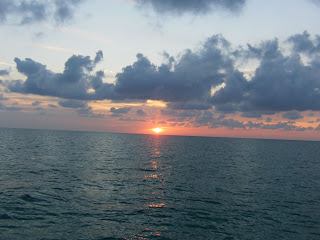The bottom of your boat is akin to the bottom of your car. There is a lot going on down there but for the most part, as long as things are working, we tend to let well enough alone. Seems like a reasonable strategy. My challenge, however, is the 'leaving well enough alone' part. Most of the projects I work on while aboard Maya are self inflicted. I seem to be able to find problems where there are none.
Such was the case a few days ago.
We were at a party the other night and one of our good boating friends mentioned to us that he had a great discount at one of the local prop shops. This shop would pick up the props, polish and rebalance them and then return them to the boat. It sounded like a great deal. He asked when the last time we had this done. It didn't take me long to answer. "Never." Well, from the look on his face, I knew that my answer didn't fall into the category of responsible boater. "Never, he said?" "Well, yeah." I said.
"I clean them up when I have the boat pulled but I have never had them off to be rebalance."
He said, "well you need to do this right away. It will make your boat run so much smoother... and you will save fuel in the process." That sounded great to me. Besides, I was in between boat projects and this sounded like a lot of fun.
A few days later, we arranged to have him stop by and pull the props off the boat. Another friend in the marina was doing his props too and we all decided to help each other with the process. What needed to be done was to dive under the boat, remove several large nuts that hold the prop onto the shaft and then (theoretically) slide the prop off the shaft and lift it out of the water. How hard could that be?
The first thing that I will tell you was that the water was cold. Even with a wet suit, you could still feel the chill around your hands, face and head. It was going to be a tough job. Things went pretty well on the first boat we did. The props came off pretty quickly and without much trouble. Maya, however, was determined not to give up hers without a fight.
Now I really don't know how long it had been since the props were off the boat. I can say for sure that it has been over five years and I would be willing to bet that it has been over ten. Metals that are submersed in salty water for long periods of time tend to take on properties that are unlike those exposed to the air. The large metal nuts that held the prop on the shaft were apparently very happy in their present state and were not interested in coming to the surface. Even with our very large pipe wrenches, it was difficult to get them to budge. There was a lot of banging and pulling but we finally got the port side prop off. It took almost an hour just to do that one alone!
The starboard side was going to be more problematic. As it turned out, there was no way we were going to be able to loosen the nuts that held the prop in place. We tried everything. At one point, we had three guys under the boat, with one person with his back on the keel, pushing with his legs against a pipe wrench that we had added a 5 foot extension to. That is a lot of torque. Finally we threw in the towel and admitted defeat. We were going to have one shiny prop and one, well, not so shiny.
A few days later, the props (our single prop and our friends double) were ready. My gosh, they were beautiful. They were so clean and shiny that they looked like solid gold. They are solid brass, btw.
Putting them back on was a lot easier. They simply slid on the shaft. We added the two bolts and cotter pin that held them in place and we were good to go.
All in all, this job I thought would take just an hour or so, wound up taking over six. Even with that, we still were only able to get one of Maya's props done. Later on, I did buy some 80# wet sand paper to use on the 'stubborn side'. I spent about a half hour sanding away under water. While she isn't as beautiful as her sister on the port side, the starboard side now looks a lot better!
I have to thank my wonderful boating friends Bill, Stephen, George and Dick for helping out with this project. It wouldn't have happened without you. Guys like them are what make boating such a great experience.
.
















































